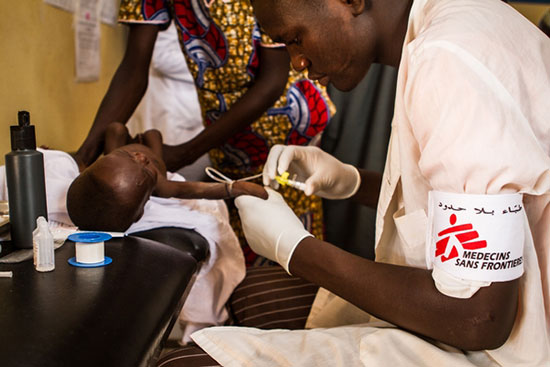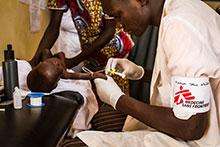Diseases Must Be Tackled Together to Pre-empt Another Crisis
Increasing numbers of children are being treated for malaria and malnutrition in southern Niger compared to one year ago.

Niger 2012 © Tanya Bindra
An MSF nurse inserts an IV drip for a malnourished child in Guidan Roumdji, where the populace is facing a peak of malaria and malnutrition.
MADRID/NEW YORK, APRIL 25, 2013—Increasing numbers of children are being treated for malaria and malnutrition in southern Niger compared to one year ago, suggesting that 2013 may see higher peaks of the two diseases than in previous years, the international medical humanitarian organization Doctors Without Borders/Médecins Sans Frontières (MSF) warned in a report released today.
With the rainy season approaching, and more cases of malnutrition and malaria expected, an integrated approach to preventing and treating malaria and malnutrition together is essential in order to stave off another crisis.
“Urgent action is needed to stop children from continuing to die from these preventable causes,” said Luis Encinas, MSF’s program manager for Niger. “To tackle malnutrition and malaria, we need innovative approaches, and we need to work on two levels at the same time: prevention and cure.”
Malaria and malnutrition are closely related. The months of the "hunger gap," when malnutrition is at its peak, coincide with the rainy season, when mosquitoes breed and malaria cases increase dramatically. The diseases combine in a vicious cycle: malnourished children have weakened immunity, making them susceptible to malaria, while children sick with malaria are more likely to become dangerously malnourished.
Last year's malaria peak led to more than 3,000 deaths in Niger. A retrospective mortality survey carried out by MSF in the districts of Madaoua and Bouza showed that deaths among children under five were at three times the emergency threshold, with malaria accounting for more than half of the deaths. The peak also caused a sharp increase in the number of children admitted to hospital with severe malnutrition.
Over recent years, strategies for combating malnutrition have shifted to include prevention in addition to treatment. A similar approach can be applied toward fighting malaria. MSF plans to implement a new malaria prevention strategy known as seasonal malaria chemoprevention (SMC) in Niger's Madaoua district this year. The strategy involves pre-emptively providing a full course of antimalarial treatment to children at intervals during the peak malaria season, from July to October. MSF successfully used this strategy in Mali and Chad in 2012.
“The effort being made to treat malnutrition in Niger is tremendous, and this needs to be supported,” said José Antonio Bastos, president of MSF in Spain. “The problem in 2012 was that a massive plan for treating malnutrition was prepared and implemented, but it excluded other health needs, in particular malaria prevention and immunizations. It failed to take account that even if you provide children with appropriate nutrition, you can still lose them to malaria or a respiratory infection. There is a need for an integrated response, rather than for pushing one response to the exclusion of others.”
Malaria prevention must be integrated into basic health measures aimed at all young children in Niger, MSF said.
MSF carried out a number of activities in Niger in 2012 aimed at improving access to health care for children under five and for pregnant women. Medical teams in the regions of Zinder, Maradi, and Tahoua run outpatient feeding programs in some 37 health centers. Severely malnourished patients requiring hospital care were admitted to inpatient feeding centers in Zinder, Magaria, Madarounfa, Guidan Roumdji, Madaoua, and Bouza. In 2012, more than 90,000 children with acute malnutrition and 390,000 children with malaria were treated in medical facilities managed by MSF and its partners.




